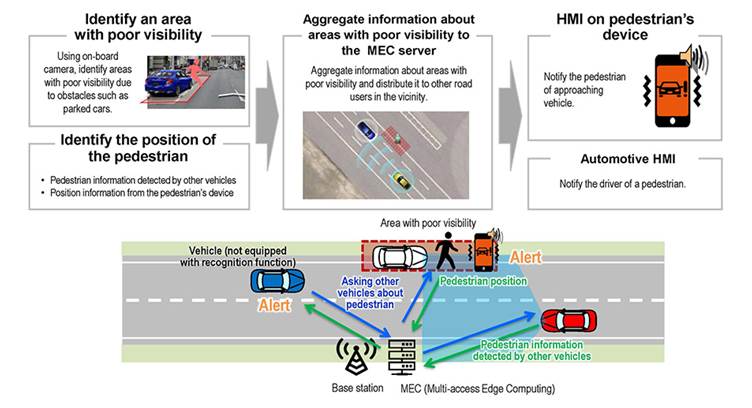SoftBank and Honda R&D have started a use case-based verification of technologies to reduce collisions between pedestrians and vehicles using a 5G standalone mobile communication system (5G SA) and a cellular V2X communication system (cellular V2X).
Using SoftBank's 5G SA experimental base station installed at Honda's Takasu Proving Ground and Honda's recognition technology, SoftBank and Honda are conducting technology verifications for the following three use cases:
Use Case 1: Reduce collisions involving pedestrians who are visible to vehicles
In an environment where a pedestrian can be seen from the moving vehicle, and when the vehicle's on-board camera recognizes the risk of a collision such as the pedestrian entering the roadway, the vehicle sends an alert to the pedestrian's mobile device directly or via an MEC server.
Use case 2: Reduce collisions involving pedestrians who are not visible to vehicles
In an environment where a pedestrian cannot be seen from the moving vehicle due to obstacles such as parked cars along roadsides, the vehicle checks with mobile devices and other vehicles nearby about the presence or absence of a pedestrian in an area with poor visibility.
Use case 3: Reduce collisions involving pedestrians by sharing information about areas not visible to vehicles
The moving vehicles send information about the areas with poor visibility to the MEC server, and the MEC server organizes the information and notifies vehicles driving in the vicinity. When a vehicle receives the notification and approaches an area with poor visibility, it checks with the MEC server about the presence or absence of pedestrians. If there is a pedestrian present, the MEC server sends an alert to the vehicle and the pedestrian.
These high-speed data communications between the MEC server, vehicles, and pedestrians will help prevent collisions. In this use case, it is possible to send information about an area with poor visibility to vehicles that are not equipped with a camera-based recognition function, which makes it possible to prevent collisions between vehicles and pedestrians regardless of whether vehicles have recognition functions.




















